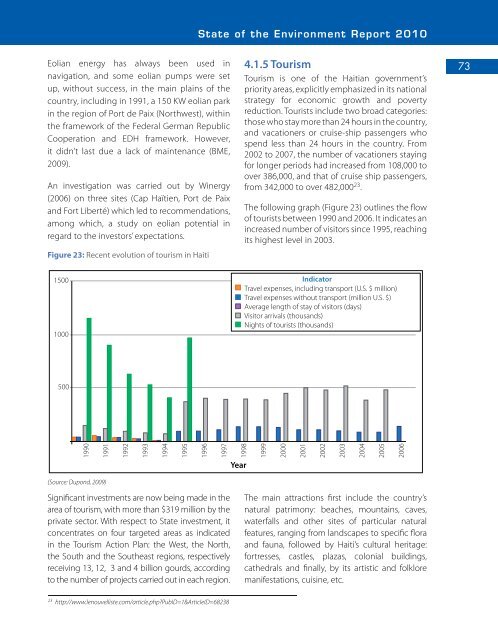GEO Haiti 2010
GEO Haiti 2010
GEO Haiti 2010
You also want an ePaper? Increase the reach of your titles
YUMPU automatically turns print PDFs into web optimized ePapers that Google loves.
State of the Environment Report <strong>2010</strong><br />
Eolian energy has always been used in<br />
navigation, and some eolian pumps were set<br />
up, without success, in the main plains of the<br />
country, including in 1991, a 150 KW eolian park<br />
in the region of Port de Paix (Northwest), within<br />
the framework of the Federal German Republic<br />
Cooperation and EDH framework. However,<br />
it didn’t last due a lack of maintenance (BME,<br />
2009).<br />
An investigation was carried out by Winergy<br />
(2006) on three sites (Cap Haïtien, Port de Paix<br />
and Fort Liberté) which led to recommendations,<br />
among which, a study on eolian potential in<br />
regard to the investors’ expectations.<br />
Figure 23: Recent evolution of tourism in <strong>Haiti</strong><br />
4.1.5 Tourism<br />
Tourism is one of the <strong>Haiti</strong>an government’s<br />
priority areas, explicitly emphasized in its national<br />
strategy for economic growth and poverty<br />
reduction. Tourists include two broad categories:<br />
those who stay more than 24 hours in the country,<br />
and vacationers or cruise-ship passengers who<br />
spend less than 24 hours in the country. From<br />
2002 to 2007, the number of vacationers staying<br />
for longer periods had increased from 108,000 to<br />
over 386,000, and that of cruise ship passengers,<br />
from 342,000 to over 482,000 23 .<br />
The following graph (Figure 23) outlines the flow<br />
of tourists between 1990 and 2006. It indicates an<br />
increased number of visitors since 1995, reaching<br />
its highest level in 2003.<br />
73<br />
1500 Indicator<br />
Travel expenses, including transport (U.S. $ million)<br />
Travel expenses without transport (million U.S. $)<br />
Average length of stay of visitors (days)<br />
Visitor arrivals (thousands)<br />
Nights of tourists (thousands)<br />
1000<br />
500<br />
1990<br />
1991<br />
1992<br />
1993<br />
1994<br />
1995<br />
1996<br />
1997<br />
1998<br />
1999<br />
2000<br />
2001<br />
2002<br />
2003<br />
2004<br />
2005<br />
2006<br />
Year<br />
(Source: Dupond, 2009)<br />
Significant investments are now being made in the<br />
area of tourism, with more than $319 million by the<br />
private sector. With respect to State investment, it<br />
concentrates on four targeted areas as indicated<br />
in the Tourism Action Plan: the West, the North,<br />
the South and the Southeast regions, respectively<br />
receiving 13, 12, 3 and 4 billion gourds, according<br />
to the number of projects carried out in each region.<br />
The main attractions first include the country’s<br />
natural patrimony: beaches, mountains, caves,<br />
waterfalls and other sites of particular natural<br />
features, ranging from landscapes to specific flora<br />
and fauna, followed by <strong>Haiti</strong>’s cultural heritage:<br />
fortresses, castles, plazas, colonial buildings,<br />
cathedrals and finally, by its artistic and folklore<br />
manifestations, cuisine, etc.<br />
23<br />
http://www.lenouvelliste.com/article.php?PubID=1&ArticleID=68238

















